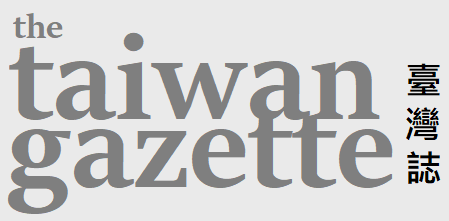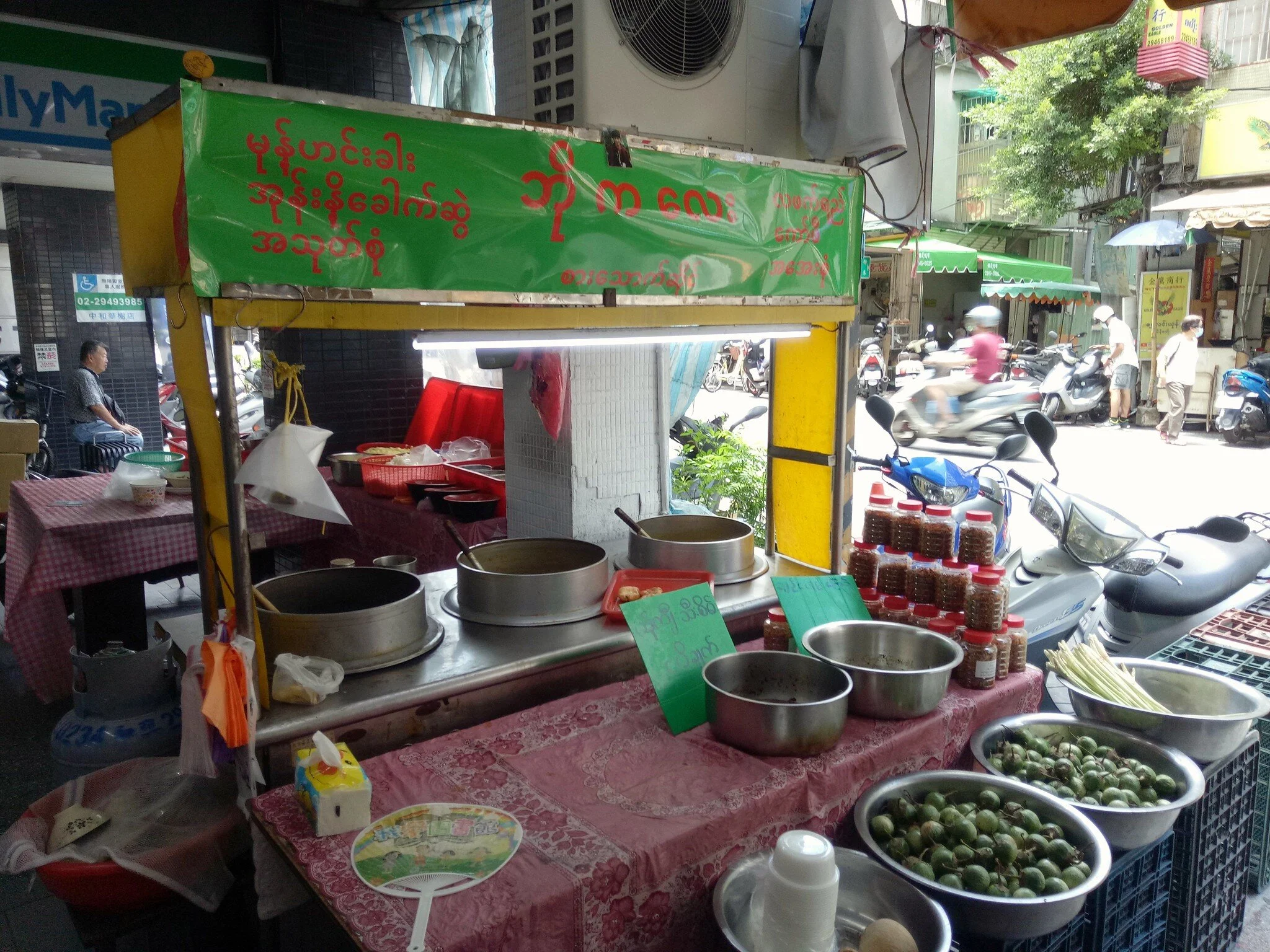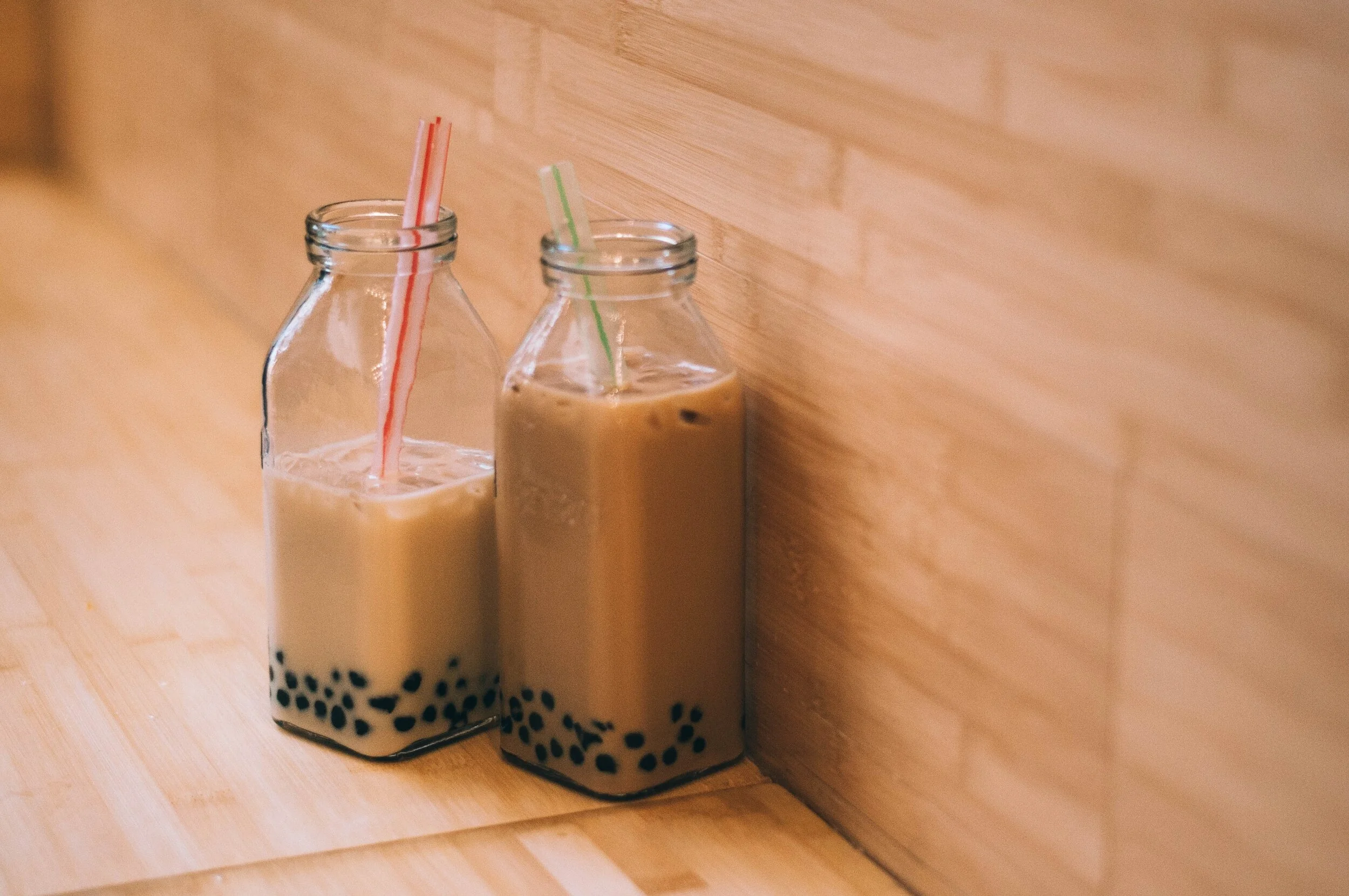A Cup of Myanmar Milk Tea and Homesickness: A History of Huaxin Street
Huaxin Street, also known as Little Burma, is home to a large overseas Burmese-Chinese community in Taiwan. How did this community come to be? How did the overseas Chinese policies of “Free China”’ contribute to this rise of this community? What can we learn from this community’s relationship with its “homeland”?
By Hsu
Translated by Grace Ho Lan Chong
Edited by Sabrina Teng-io Chung
Cover Image by Foxy1219
This piece first appeared in StoryStudio and was translated and published with the permission of the publisher.
Our interest in lieux de memoire where memory crystallizes and secretes itself has occurred at a particular historical moment, a turning point where consciousness of a break with the past is bound up with the sense that memory has been torn--but torn in such a way as to pose the problem of the embodiment of memory in certain sites where a sense of historical continuity persist.
- Pierre Nora, “Between Memory and History: Les Lieux de Mémoire”
Huaxin Street, the street near the MRT Nanshijiao Station, is commonly linked these days to various cultural elements of Myanmar, such as Myanmar milk tea, Thingyan Water Festival (潑水節), street pancakes, mohinga, and more. Due to its exotic atmosphere, it is also called “Myanmar Street.” But have you ever wondered why there is such a large overseas Burmese-Chinese community in New Taipei City?
The roly-poly looking Burmese language, delicious and decadent looking food photos on the menu also indirectly illustrate the transformation of Huaxin Street over the recent years.
To retell a history of Huaxin Street, one must start from the arrival of Chiang Kai-shek and his Kuomintang personnel in Taiwan. Despite losing to the Communist Party and needing to flee, the Nationalist government still needed to carry the calling card of “Free China” abroad. Thus, the Nationalist government continued to fly under the banner of “the Final Anti-Communist Fortress in the Chinese World” to secure overseas recognition.
In 1950, in his broadcasted speech to overseas Chinese in Southeast Asia, Chiang Kai-shek highlighted that “the three pillars of anti-communism include the overseas Chinese community, Taiwan’s National Army with 600,000 men, and the Anti-Communist forces in mainland China.” The following year, the Executive Yuan implemented the “Policy on Overseas Chinese Affairs in the Anti-Communist and Anti-Russia Period” (反共抗俄時期僑務政策), and launched active propaganda and appeals targetting overseas Chinese. The content included the unification of overseas Chinese against the aggression of international communism, the restoration of the overseas Chinese community’s confidence with the government, the improvement of the cultural level of overseas Chinese and the reinforcement of their understanding of the motherland. “Anti-communism” became the most important task of overseas community affairs.
SECURING RECOGNITION FOR FREE CHINA
To secure the legitimacy of its regime in a time of emergency, overseas Chinese policy became crucial to the Nationalist government. Shortly after arriving in Taiwan, Chiang Kai-shek established the “Kuomintang Central Reform Committee” (國民黨中央改造委員會), aiming to realign the “morals” of the Kuomintang Party. According to him:
“When I retired in early 1949 (Minguo Year 38), I reflected deeply on the fundamentals of building the party and the country, the basic policy for anti-communist and anti-Soviet resistance. These reflections were based upon my personal confessions, the rules and conduct of comrades, an analysis of the revolutionary environment, and the results of my overall understanding of the global situation. Only then was I able to determine the Party’s future revolutionary policy.”
Overseas Chinese policy is a part of Chiang’s reform efforts. From the legal basis of the “Guideline for the Enrollment of Hong Kong and Macau High School Graduates in High Standing” (港澳高中畢業成績優良學生保送辦法) and “Measures for Preferential Treatment of Overseas Chinese Students” (華僑學生優待辦法), the “Measures for Overseas Chinese Students Applying for Admission to Study in Taiwan” (華僑學生申請保送來臺升學辦法) and “Preferential Treatment for Overseas Chinese Students Applying to Colleges in Taiwan” (僑生投考臺省專科以上學校優待辦法) were promulgated, further lowering the threshold for overseas Chinese to study in Taiwan. As long as they were voluntarily choosing to study in Taiwan--secondary and above--overseas Chinese students could apply for admissions, access test-free distribution, and have lenient examinations. At the same time, to take care of overseas Chinese students from communist countries including North Vietnam, Indonesia, Burma, and more, the Nationalist government granted them public subsidies comparable to that of students attending normal schools.
The comic books given to elementary school students at the time also carried the teachings of the greats. (Remake from “Chinese Cartoons Children’s Comic Story Album”)
The Kuomintang Central Standing Committee (中常會) immediately adopted the policy for “The consolidation of overseas Chinese affairs through diplomacy, the development of party affairs with overseas Chinese affairs, making party affairs the core of overseas Chinese affairs, and relying on overseas Chinese affairs as diplomatic backing.” Overseas Chinese affairs became the top priority of the contemporaneous government. On one hand, the ‘overseas Chinese’ had been included as part of the vision of Greater China, becoming an “othered self,” an awkward presence caught between the Republic of China’s group-self and its enemy “Others.” On the other hand, to avoid isolating the Nationalist regime in Taiwan, the government sought the support of overseas Chinese through the ideas of consanguinity and ethnic identity, “uniting the global Chinese diaspora against communism” and strengthening the image of Taiwan in the world as the only legitimate government of China.
These policies’ main objectives were to “cultivate national awareness in overseas Chinese, improve their economic life and enhance their political status.” The Overseas Community Affairs Council (僑務委員會) first hosted the Global Overseas Chinese Culture and Education Conference in 1955, attempting to attract the attention of overseas Chinese with “Overseas Chinese Education.” Encouraging overseas Chinese to study in Taiwan also meant strengthening their affinity with the “legitimate China” in Taiwan, preventing them from being “led astray” by communism. They could become good Chinese citizens serving in the motherland and their overseas community.
I once interviewed a lady from Myanmar known as Aunt Wang. She clearly explained the reason for her and her family relocating to Taiwan: “At that time, overseas Chinese could return to the motherland (referring to the Republic of China) to study. The government stated that an ID card would be issued if you returned to study.” However, with the “Overseas Chinese Certificate” issued in Myanmar, one could not purchase a house or property, and your national status would not be recognized by the government. Thus, the conditions in the Republic of China were indeed very attractive to them.
In the 1950s, although the number of overseas Chinese arriving in Taiwan to continue their studies slowly increased, they still belonged to the minority. Due to the dissatisfactory admission conditions in schools, the Overseas Community Affairs Council negotiated with the Ministry of Education to provide incentives, stipulating that universities accepting one overseas Chinese student would receive a subsidy of NT$10,000. This money had also assisted many schools in constructing school buildings. The early buildings of National Taiwan University, National Taiwan Normal University, National Chengchi University, and National Defense Medical College were completed, in large, due to these subsidies. With more overseas Chinese students choosing Taiwan, the policy even received the endorsement from the Dwight D. Eisenhower Administration (1953–1960) of the United States. In his 1958 Congress Address, Eisenhower suggested that the 8,000 overseas Chinese students studying in Taiwan signifies the overseas Chinese community’s recognition of the Republic of China. [1]
A news report on Eisenhower’s 1958 Congress Address.
What does it mean? To provide further historical context, after its relocation to Taiwan, the Nationalist government began to actively promote the re-sinicization of Taiwan, not only transforming Taiwan’s existing culture but simultaneously declaring to the international community: “This is the final fortress of a free China” against communism. These propaganda have also positioned the Republic of China in Taiwan as the legitimate representative of China, the “Motherland” of the vast overseas Chinese community. A number of overseas Chinese were attracted to Taiwan, despite not having travelled from Taiwan to Nanyang (南洋) in the first place. For the Republic of China, overseas Chinese were not only a political bargaining chip and an identification symbol; they also served a propagandist role to everyone on the island of Taiwan: we are all Chinese.
OVERSEAS BURMESE-CHINESE COMING TO TAIWAN
The overseas Burmese-Chinese who arrived in Taiwan can be roughly divided into several categories: school students, post-war military personnel “returning to” Taiwan from Burma, and ordinary people arriving in Taiwan in the 1980s after the anti-Chinese movement. There are also many differences within these three groups of overseas Chinese, and they were relocated to different regions in Taiwan after arriving. For example, military personnel can be subdivided into two categories: intelligence personnel working behind enemy lines in Burma under Japanese invasion and Kuomintang troops fighting on the Sino-Burmese border in the early 1950s. The former largely settled in the Taipei Shilin area (台北士林) and the latter scattered across Zhongli Longgang (中壢龍岡), Nantou Qingjing (南投清境) , Kaohsiung Jiyang (高雄吉洋), and other places.
On Huaxin Street, we can mostly find the third group of immigrants. Due to the tense situation in Burma at that time, with the help of relatives and friends, most people settled in the old Burmese-Chinese settlements or new towns, such as Zhonghe, Yonghe, Xindian, Banqiao, Tucheng, etc. I once interviewed the owner of a small snack bar who was part of the third batch of immigrants. She also explained that coming to Taiwan was not easy: “My relative is an officer of Kuomintang, so I had the opportunity to move to Taiwan. We were a group of relatively lucky people.”
Chinese language intensive courses were also one of the voters’ services provided by legislators. Many overseas Chinese from then-Burma arriving in Taiwan learned and strengthened their Chinese in these courses.
As a new town close to Taipei, Zhonghe had low land prices and was very convenient. Therefore, many factories chose to set up there. The presence of factories would bring employment opportunities, which would further increase the town’s attractiveness to overseas Chinese. However, with Taiwan’s economic development and urbanization, many urban and rural immigrants from southern Taiwan who came to Taipei for opportunities also settled in Zhonghe and Yonghe. The unique foreign temperament and cultural landscape of Huaxin Street seemed out of place in the increasingly dense Taipei Metropolitan Area. This sense of foreignness and incomprehension led to the street being dubbed “foreign” by locals.
Myanmar-born Taiwanese film director Midi Z (趙德胤) once lived in Zhonghe. He shot a 20-minute short film, “Huasin Incident” (華新街記事), in the first Golden Horse Film Academy in 2009. The film features actors with strong accents, and is composed of gloomy-toned images, long shots of young people running, scenes of free-flow alcohol, swearing, and gambling. These were not just a reflection and recollection of the director’s own youth and upbringing, but also the depression and tension in the hearts of two generations of overseas Burmese-Chinese. It was a profile of a heterotopia at the edge of the city.
Of course, what the director presents is an insider’s perspective of Huaxin Street unfamiliar to outsiders of the community. Taiwanese and Burmese-Chinese sharing these communities, with cultures and race intermingling, were in a constant state of unease and distrust. Frequent reports of theft and drug use, negative sentiments and xenophobic views meant those considered non-locals were labelled negatively, leading to high tensions.
Midi Z’s short film brought to light the stigma and negative perception surrounding Huaxin Street. Scholar Chiou Shwu-Wen (邱琡雯) used the idea of “ghetto pathology” (移民區病理) to explain why Huaxin Street might have been stigmatized as such. Hostile towards the Burmese-Chinese community, local Taiwanese “see the high concentration of immigrants and their residence and business as social cancer, a hotbed of poverty, crime, violence, and a habitat ground for people with low education and low income.” In this way, Huaxin Street had become an “inner city” in Greater Taipei. It was a space for ethnic minorities outside the “city” dominated by the middle class. Until recently, the New Taipei City Government’s vigorous transformation and promotion of tourism have gradually wiped out the mainstream society’s colored vision of Huaxin Street, and has put it under a tourist gaze of another kind, but that’s a story for another time.
DIASPORIC MEMORY, DISPLACED IDENTITY
The Republic of China’s acceptance of “overseas Chinese” wasn’t just a matter of cultural tolerance, but also about stabilizing oneself, assimilating overseas Chinese into its group-self or a part of the cultural bloodline. At the same time, overseas Chinese arrived at their “motherland” on the same basis of recognition. However, from the moment they stepped foot onto the Taiwan Taoyuan International Airport, this concept of “motherland” has long become vague and incorporeal, ceasing to exist in material reality. Everything became different on the ground.
Perhaps, it was also only after arriving in Taiwan that they discovered this place was not the country they had expected, and the group of “comrades from the motherland” that they had been waiting for in their hearts turned out to be different than they expected. After repeated displacements, from China to Burma, and from Burma to Taiwan, such an intense diasporic experience made it difficult for them to settle on one single identity.
This type of diasporic consciousness is shared among many. The lady owner of the snack bar on Huaxin Street told me at the end of our chat: “Wherever we go, we are still overseas Chinese and will always be overseas Chinese . . . Coming to Taiwan, a place where many Chinese people live, we found things easier to cope with, and life is a bit closer to who I really am.”
Afternoon on Huaxin Street. You can often see locals sitting on the roadside drinking milk tea, gossiping away. The habit of afternoon tea has travelled all the way from Burma, which had experienced British colonization, to Taiwan.
Footnote:
[1] In 1957, John Foster Dulles, then US Secretary of State, mentioned in a speech debating the possible consequences of the US diplomatic recognition of Communist China. Dulles said:
“The number of Chinese students from overseas communities coming to Free China has increased year by year; the number going to Communist China has declined, and hundreds of disillusioned students have made their way out of mainland China in the past two years. If the United States recognized the Chinese Communist regime, many of the millions of overseas Chinese in free Asian countries would, reluctantly, turn to acceptance of the guiding direction of the Communist regime. This would be a tragedy for them; and it would imperil friendly governments already menaced by Chinese Communist subversion.”
Bibliography:
Fan Yamei, “An analysis of KMT’s homeland policy after 1949: From the perspectives of diasporic regime, local knowledge and international context,” Master’s Thesis, Institute of Sociology, National Taiwan University, 2005.
Zhai Zhenxiao, “Migration, Cultures and Identities: The Social Construction and Transnational Networks of Burmese-Chinese Immigrant Communities in Yangon, Jhong-he, and Toronto,” Master’s Thesis, Institute of Anthropology, Tsinghua University
Wakamatsu Daisuke, “Official Nationalism in Taiwan’s Modern History and the Image of the Thai-Myanmar Army,” 2013
Chiou Shwu-Wen, “The Conflict and Breakthrough between Ghetto Pathology and Network Nodal Points: The Case of the Vietnamese Female Restaurant Owners in Taiwan,” 2007.
Xia Chenghua, “Research on Overseas Chinese Affairs and Education since the Establishment of the Republic of China,” 2005.
Prepared and printed by the Overseas Community Affairs Council, “Research on the Future Development Trend of Our Country’s Overseas Chinese Education Policy”, 2010.
Gao Xin, “Overseas Chinese and Overseas Chinese Affairs in the Republic of China,” 1989.












